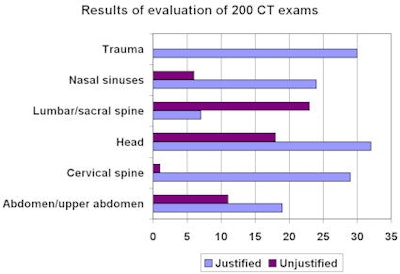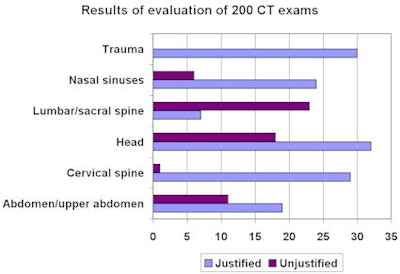
Nearly one-third of a sample of pediatric CT scans from a hospital in Finland were found to be clinically unjustifiable, according to research published online in the journal European Radiology.
An evaluation of 200 randomly selected CT exams performed in 2005 on patients younger than 35 at the hospital found that approximately 30% of the procedures were not justified. Of these unjustified examinations, most could have been replaced by MRI studies, according to the researchers from Oulu University Hospital in Oulu (European Radiology, January 21, 2009).
Radiologists at Oulu University Hospital conducted the audit to determine how many of the hospital's younger patients were being inappropriately exposed to high radiation doses, as well as what level of education needed to be provided to referring physicians. Of the 200 patients whose medical files were evaluated, 15 were children 15 years of age or younger.
In 2005, 11% of 148,988 radiology procedures performed at the hospital were CT scans. Of the 16,975 CT scans, 14%, or 2,367 exams, were performed on patients who were younger than 35 years. The majority (1,063) were head exams, followed by thorax or lung (241), lumbar and sacral spine (130), abdomen (123), trauma (117), cervical spine (110), and nasal sinuses. The researchers consecutively selected a sampling of these procedures starting January 1, 2005, for evaluation.
Patient files, clinicians' referrals, and indications and findings of the examinations were analyzed by an experienced radiology specialist. Using this analysis and the 2001 Referral Guidelines for Imaging of the European Commission, the researchers determined if the CT scan was justified and, if it was not, whether a different diagnostic imaging examination could have been performed.
Justification criteria included the following:
- Head CT exams were indicated in trauma or acute cases such as suspicion of intracranial bleeding or acute stroke. MRI exams should have been used for elective cases.
- CT exams of trauma patients were justified and included trauma to the cervical spine.
- CT exams were appropriate for trauma and control of fixation of the lumbar spine. MRI was recommended for cases of disk syndrome of the lumbosacral area.
- CT exams were justified for patients having functional endoscopic sinus surgery.
All abdominal CT scans were evaluated on a case-by-case basis, as were other exams that did not fit into the general categories. Opinions of specialists in the radiology department were sought as needed. Differing opinions were resolved by consensus.
A total of 59 CT examinations were unjustified, according to lead author and radiologist Dr. Heijä Oikarinen. Twenty of the unjustified lumbar spine CT exams could have been replaced by MRI exams, and three additional patients did not require any radiological procedures.
Of the 11 unjustified abdominal CT exams, five should have been replaced by MRI, four by ultrasound, and one by fluoroscopy. One of these patients did not have symptoms that merited any kind of procedure. Of the six unjustified nasal sinus exams, one patient also had a head CT exam, which the radiologists considered adequate, and five of the exams could have been replaced by MRI examinations.
 |
The researchers noted that the hospital had a shortage of MRI equipment to meet needed capacity, and they alluded to the possibility that this may have been one of the reasons that some of the unnecessary CT exams were ordered. Shortly after the evaluation was conducted, an additional MRI scanner was purchased.
The researchers also stated that an educational campaign was initiated to advise referring physicians of radiation risks, radiation doses for different examinations, and the process of justification. Radiologists have also become more proactive in recommending alternative lower-dose or no-radiation-dose diagnostic imaging procedures when they believe an inappropriate order has been made.
Anecdotally, the number of unjustified CT examinations seems to be decreasing, the authors stated.
By Cynthia E. Keen
AuntMinnie.com staff writer
February 20, 2009
Related Reading
Image Gently organizers look ahead on one-year anniversary: Part I, February 5, 2009
Radiation dose awareness leads to drop in pediatric CT usage, December 12, 2008
CT experts grapple with rising concerns about radiation dose, May 14, 2008
Researchers recommend alternatives to CT, April 15, 2008
Copyright © 2009 AuntMinnie.com


















